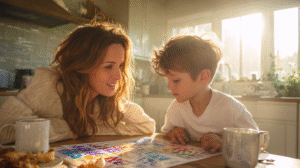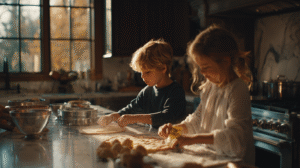
Morning Calendar Math: A Daily Routine to Build Number Sense
Morning Calendar Math: A Daily Routine to Build Number Sense As a former elementary math teacher turned homeschooling mom, I

“Mommy, why do we have eight fingers but ten toes?” That one breakfast question from my daughter changed how I see math forever. As a former middle and high school math teacher, I suddenly realized I’d been missing golden opportunities right in front of me. I had spent so much energy planning formal lessons for my first-grader, when the most powerful learning moments were already happening—through our morning math routines for kids, woven into our everyday life.
After fifteen years of teaching algebra and geometry to teenagers, I’ve come to believe that the math brain isn’t built in textbooks—it’s built in those small, consistent experiences. And for young children, morning math routines for kids offer the perfect foundation: simple, natural encounters with numbers, patterns, and problem-solving during their most curious and alert time of day.

The magic begins the moment our children wake up. I’ve discovered that the simple act of getting ready for the day is packed with unnoticed math moments that most of us overlook. Instead of rushing through our morning routines, I started intentionally slowing down to notice these learning opportunities with my kids.
One of the most effective morning math routines for kids is simply letting them manage time. I give my first-grader a simple analog clock and ask her to tell me when it’s time to brush teeth or get dressed. It’s not about perfection — it’s about developing number sense and sequencing.
In the bathroom, we count toothbrush strokes, measure toothpaste, and sort toiletries by size. These small actions turn routine tasks into spatial reasoning and classification practice. The best morning math routines for kids often hide in these ordinary tasks.
Getting dressed becomes a lesson in symmetry, patterns, and logic. Talking about which sock goes on first or how many buttons we need to fasten naturally builds mathematical language without pressure.
Bonus tip: Play “sock matching” to turn sorting into a fun game. It boosts confidence and introduces important math concepts like pairs, similarity, and difference in a playful way.
The kitchen has become our most powerful classroom. Morning routines often include breakfast prep — and with a bit of intention, this transforms into a daily math opportunity.
Morning math routines for kids come alive when we pour milk and talk about “half-full” vs. “empty.” Even toddlers can explore fractions this way. My older child uses measuring cups to make pancakes or count coffee scoops for Dad.
Setting the table becomes a natural multiplication lesson. How many plates, forks, and napkins do we need? We count in groups, practicing one-to-one correspondence and early multiplication thinking. When guests come over, we scale up — a real-world application of grouping and addition.
Cooking times? Great for subtraction and sequencing. We estimate when toast is ready or when to flip pancakes. And when it’s time to divide muffins fairly, we talk about equality and sharing — core division skills.
These experiences are multisensory and joyful. One of the greatest values of morning math routines for kids is that children can see their reasoning produce real, delicious results.
Before breakfast, there’s often a quiet window when children are alert but not yet busy. I protect this time for math play — low-pressure, high-value moments that foster problem-solving and creativity.
From building blocks to puzzles, these hands-on tools spark spatial awareness and logical thinking. When we build towers and ask, “How can we make it taller?” or “What if we added another block?”, we’re engaging in real geometric exploration — one of the more effective morning math routines for kids.
My kids create breakfast patterns using cereal, fruit, or utensils. It builds early algebraic thinking. Sometimes we sort toys by size or color and talk about our criteria — that’s data literacy in its earliest form.
We follow their curiosity: blocks one day, puzzles the next. The best morning math routines for kids adapt to interest and energy, making math feel like fun, not a subject.
Some of the most impactful morning math routines for kids happen when we simply talk math during daily life. There’s no worksheet involved — just awareness.
We count steps down the stairs, birds outside, or pieces of cereal in a bowl. We count forward, backward, in twos or fives — all within the flow of our morning.
Comparison language adds depth: “Which bowl is bigger?”, “Who’s taller today?”, “Which sock took longer to find?” These informal measurements strengthen reasoning and vocabulary.
We spot shapes around the house — triangles on rooftops, circles on clocks, rectangles on the fridge magnets. These spontaneous observations plant early geometric knowledge.
And we estimate: “How many sips will finish that juice?” or “How many minutes to brush your hair?” These light conversations offer some of the richest morning math routines for kids, because they come naturally and without pressure.
What matters most isn’t how “mathy” the morning looks — it’s that it happens, consistently. That’s why I advocate for morning math routines for kids that are simple, repeatable, and flexible.
Counting stairs. Noticing patterns. Comparing sock lengths. Celebrating when your child spots symmetry on their own. These are the wins.
Adjust routines by age: my preschooler counts to ten, while my first-grader adds small numbers. Both are doing math — at their own pace, in their own way.
When we remove pressure and focus on joy, we make space for exploration and connection. That’s what great morning math routines for kids are built on — a loving relationship, playful learning, and a little consistency.
As I watch my children engage with numbers during breakfast or while brushing their teeth, I’m reminded: learning happens in the margins of life, not just the classroom.
These small, repeated routines aren’t just building number sense — they’re building confidence, curiosity, and joy around math. They’re shaping how our children will feel about learning for years to come.
You don’t need apps or worksheets. You need attention, intention, and a bit of morning magic.
Morning math routines for kids don’t require planning — just presence. And in those moments before the world gets noisy, we’re building not just math brains, but confident thinkers who believe math belongs in their world.

Morning Calendar Math: A Daily Routine to Build Number Sense As a former elementary math teacher turned homeschooling mom, I

Brushing Teeth Countdown: 5 Powerful Fun Tips for Kids As a former math teacher turned mom of two, I thought

Cooking Fractions for Kids: 7 Fun & Tasty Ways to Learn Math Last Tuesday, my 8-year-old son Jake stared at
*Also read:
25 Brilliant LEGO Math Activities to Build Number Sense and STEM Skills at Home
Teach Kids to Tell Time: The Clock Game Every Parent Should Try at Home